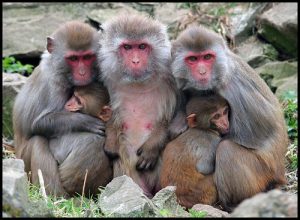12 Masculinities
Another concept that troubles the gender binary is the idea of multiple masculinities (Connell 2005). Connell suggests that there is more than one kind of masculinity and what is considered “masculine” differs by race, class, ethnicity, sexuality, and gender. For example, being knowledgeable about computers might be understood as masculine because it can help a person accumulate income and wealth, and we consider being the “breadwinner” to be masculine. However, computer knowledge only translates into masculinity for some men. While an Asian American, middle-class man might get a boost in “masculinity points” (as it were) for his high-paying job with computers, the same might not be true for a working-class white man whose white-collar desk job may be seen as a weakness of masculinity by other working-class men. Meanwhile, strength and aggression tends to be valued in white men but feared in Black men. Expectations for masculinity also differ by age; what it means to be a man at 19 is very different than what it means to be a man at 70. Therefore, masculinity intersects with other identities and expectations change accordingly.
Tough Guise 2
Answer the following questions while watching: Tough Guise 2: Violence, Manhood & American Culture.
- Why is it problematic for newscasters and pundits to use “gender-neutral” language to talk about mass shootings in the US?
- Who is missing from the phrase “violence against women”?
- Fill in the blank: “That’s one of the ways that the power of dominant groups isn’t questioned – by remaining ____________________.”
- What’s wrong with dismissing men’s violence with the phrase “boys will be boys,” or claiming that they’re “naturally” aggressive because of testosterone?
- What are two mutually reinforcing institutions supporting the culture of male violence in the US, according to the documentary?
- In the dominant culture, what is the primary means for boys/men to win respect and establish their masculine credibility?
- Why do African American, Latino American, Asian American, and Native American men, respectively, adopt a certain “cool pose” to assert their masculinity? (hint: think about the intersections of race, gender, and class).
- What is “backlash masculinity”?
- Why can’t violence be reduced to mental illness?
- Who (as in which gender demographic) suffers from the highest number of gun-related fatalities?
Jack Halberstam used the concept of female masculinity to describe the ways female-assigned people may accomplish masculinity (1998). Halberstam defines masculinity as the connection between maleness and power, which female-assigned people access through drag-king performances, butch identity (where female-assigned people appear and act masculine and may or may not identify as women), or trans identity. Separating masculinity from male-assigned bodies illustrates how performative it is, such that masculinity is accomplished in interactions and not biologically determined.
“The Trouble with Testosterone”
Recall, from Unit 1, the concept of biological determinism. Biological determinism is the belief that animals’ (including humans’) biological characteristics, such as hormones or chromosomes, somehow determine their behavior. The claim that men are, on average, more aggressive than women because men have higher, on average, levels of testosterone, rests on this belief in biological determinism.
If we look carefully at the biological evidence, however, it turns out that testosterone does not cause aggression. Biologist Robert Sapolsky explains this seeming contradiction in his 1997 book The Trouble with Testosterone, using laboratory, non-human animal, and human studies as evidence, and there have since been multiple books and articles (e.g., Fine 2017, Karkazis et al. 2012) further supporting the fact that testosterone neither causes aggression nor improves athletic ability (a finding that seems to escape heated discussions of trans and intersex athletes).[1]
Sapolsky explains that while there is a relationship between testosterone and aggression, it is not the relationship people typically assume, namely that testosterone causes aggression. Instead, testosterone can increase the aggressive behavior of someone who already happens to be an aggressive individual, but even these instances are extreme examples that would not occur without hormonal intervention. And somewhat surprisingly, it is actually aggression that increases testosterone levels, not the other way around. Here are some of the biological studies Sapolsky offers as evidence:
- First, Sapolsky details how castration (!) experiments on male animals show that even once all testosterone has been removed from their bodies, male animals remain aggressive, if less so.[2] So even without the presence of any testosterone, males can still act aggressively — aggression does not drop to zero when testosterone drops to zero. What is more, when researchers inject castrated males with higher levels of testosterone, those males’ levels of aggression only show a corresponding increase once they’ve reached over two times, or more than 200% of, the normal range of naturally occurring testosterone. Sapolsky calls this the “permissive effect.” It turns out that male bodies don’t register a significant difference in hormone levels, meaning don’t respond or behave differently, when that change in testosterone levels is between 20% and 200% of the normal range. In other words, levels of testosterone only affect behavior if that level drops to below 20% of the normal range, or above 200% of the normal range, extreme conditions that would only be seen in laboratory experiments with castration, or in doping situations, such as with bodybuilders on steroids.
- Second, and relatedly, Sapolsky details an experiment conducted on five male rhesus monkeys (in captivity), who were given time to establish a group hierarchy on their own. Monkeys 1 and 2 were dominant over monkey 3, and monkey 3 was dominant over monkeys 4 and 5. Researchers then injected monkey 3 with tons of testosterone (over 200% of the normal range) and observed his behavior. Monkey 3 did increase his aggressions toward monkeys 4 and 5, but he remained submissive to monkeys 1 and 2, showing that testosterone can amplify aggression that’s already present, but that it’s not causing aggression in the first place.

- Third, Sapolsky relays the tale of a somewhat famous colony of captive hyenas who live in the Berkeley hills of Northern California, under the care of a biologist’s research laboratory. Hyenas have long fascinated a wide variety of scientists because the females tend to be more aggressive and dominant than the males, and also have higher average levels of testosterone than their male counterparts. These captive hyenas were separated from their clan in the wild as cubs, and researchers found that in captivity, even though the females still had higher testosterone levels than the males, they did not tend to dominate or be more aggressive. The biologists thus concluded that female aggression among hyenas is a learned, social trait, not one that is determined by the presence or absence of a hormone. Having been taken from the wild as cubs, these female hyenas did not learn from their female elders how they were expected to behave within the clan, vis-à-vis the male members of the clan.

How do you think Jackson Katz, the narrator of Tough Guise 2, would react to this finding that aggression is a learned behavior even among non-human animals?
- For more on the racial and gendered politics of sports, take RGS 314: "Race, Gender, and Sport" ↵
- If you're interested to learn more about the ethics of experimenting on animals, and the problematics of extrapolating from nonhuman animal behavior to human behavior, take RGS 303 "Sex, Race, and Species: Critical Animal Studies" ↵

